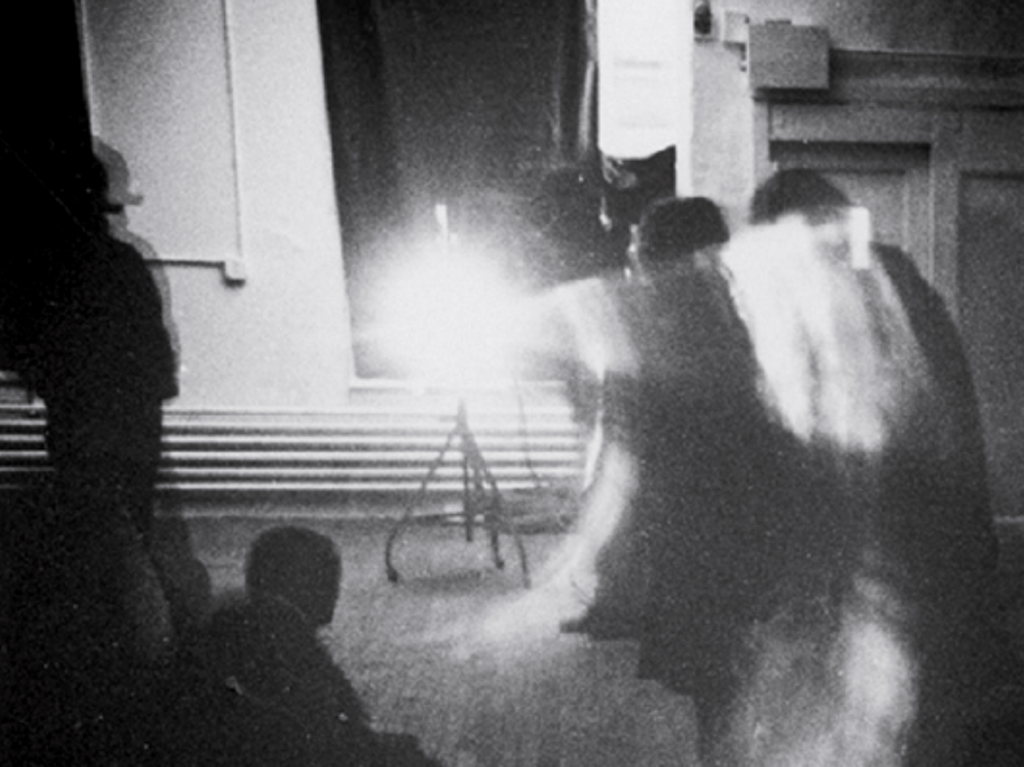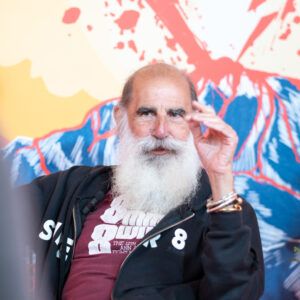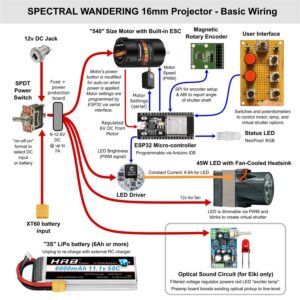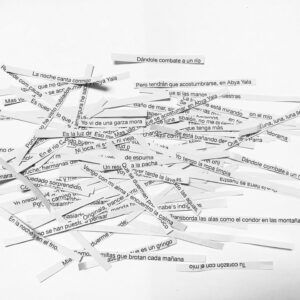
Line Describing a Cone was made in August 1973, a few months after I sailed from England to the United States. I had been thinking about it for nearly a year in London, I conceived it mid-Atlantic, and I produced it in New York. By 1973, I had already made a number of short 16mm films, but Line was the first in which I was able to implement the ideas I had been developing about the relationship between audience and work, and about film as a medium. Here is a slightly edited version of a brief statement I made about the film at the time: Line Describing a Cone is what I term a solid light film. It deals with the projected light beam itself, rather than treating the light beam as a mere carrier of coded information that is decoded when it strikes a flat surface. The viewer watches the film by standing with his or her back towards what would normally be the screen, and looking along the beam towards the projector itself. The film begins as a coherent pencil of light, like a laser beam, and develops through 30 minutes into a complete, hollow cone. Line Describing a Cone deals with one of the irreducible, necessary conditions of film: projected light. It deals with this phenomenon directly, independently of any other consideration. It is the first film to exist in real, three-dimensional space. This film exists only in the present: the moment of projection. It refers to nothing beyond this real time. It contains no illusion. It is a primary experience, not secondary: that is, the space is real, not referential; the time is real, not referential. No longer is one viewing position as good as any other. For this film, every viewing position presents a different aspect. The viewer therefore has a participatory role in apprehending the event: he or she can, indeed needs, to move around relative to the slowly emerging light form.
I would add that when the film is watched from start to finish by an audience – more than just a few individuals, say 30 or 40 people – then a second level of interaction occurs, this time between members of the audience with one another. Within the dark room, the individual audience members have to negotiate the space in relation to one another so that they can all see the light form. Paradoxically, the more people present, the more ‘solid’ the form becomes; I am always impressed by how much respect is accorded to the surface of this giant cone so that it is not obscured from sight for someone else. Since what happens at each screening between the different members of the audience is unique, perhaps it isn’t really stretching a point to see the screenings as a type of participatory performance.
Until the “Into the Light: The Projected Image in American Art, 1964-1977” exhibition at the Whitney Museum of American Art, New York, Line Describing a Cone had always been shown theatrically, which is to say that an audience assembled at a certain precise time to watch the film together. Knowing that one “has” an audience for a certain complete block of time makes it possible to control the film’s disclosure within that time period: the time can be manipulated as a plastic element. This, plus the fact that a group of people are experiencing the event together, creates a unique intensity. However, from the public’s point of view, theatrical screenings have the disadvantage of poor access. The solution for “Into the Light” was to show the film continuously within a dedicated room as an installation. Once the film was over, it started again immediately, and in this way it ran continuously throughout the day. Sometimes there would be one person, alone, other times there would be five or six, and sometimes nobody at all. This created a more “ambient” experience, closer to that of individuals coming and going through a museum room to look at a piece of sculpture. In terms of access, this solution was extraordinarily successful. A very large number of people were able to see the film during the three months that the show was up. It meant, of course, that visitors came into the room at entirely different moments during the film’s unfolding, and as is conventional in a museum, they chose how long they would give it. Some came and went after a few moments, while others saw it through to completion and even waited to see it from the start so that they could see it all the way through. At first I viewed this as a distortion of the intended experience. Now I’m not so sure. I think that perhaps it is just another version of the film.
Given a choice of rooms and projector lenses, Line Describing a Cone can be projected at any number of sizes. However, I prefer that this occur within certain limits. There are two dimensions to be considered: the length of the form (the distance between the projector and the projection surface), and the width of the cone at its base, where it strikes the wall. Thanks to different types of lenses, these can be considered separately. The length is ideally somewhere between 35 and 60 feet long. I prefer the base of the cone to be some eight or nine feet tall, starting at about a foot off the floor. The body is the important measure. Standing inside the cone near its base at the wall, where it is at its tallest dimension, the body should be completely subsumed within it. With outstretched arms it should not be quite possible to touch the upper surface. From there, if one walks down the cone towards the projector, it slowly diminishes in size until the body simply emerges out of it, arriving finally at the apex of the cone at the lens of the projector. Behind the lens, clearly visible on the film as it passes through the gate of the projector, is the miniature two-dimensional circle that generates the three-dimensional form. These issues of scale and the body, and of moving around a three-dimensional object in a three-dimensional space, are, of course, sculptural issues, and part of the resonance of the experience of looking at them is drawn from this. However, unlike sculptural materials such as steel, lead, wood, latex, felt, etcetera, light has no solidity and no gravity. In addition, the explicit control of disclosure over time, the representation of movement, the interchangeability of forms through editing, and the fact that these works have to be viewed in the dark – these are all properties of cinema. In the end, the experience of Line Describing a Cone, and the pieces that followed, depends equally on their relationship to both sculpture and to film. Visibility is also an issue. These pieces are visible in three-dimensional space, because the projected light is reflected off tiny particles in the air. In the days when they were made, loft spaces were grittier and dustier than they are now, being then much closer to their earlier lives as sites for manufacturing or warehousing; the same was true of the downtown exhibition spaces. When I projected a film then, I could rely on the dust particles in the air, which would often be augmented by a couple of smokers. Since then exhibition spaces have become cleaner and smoking has been prohibited. Fortunately, technology has caught up, and we now thicken the air with a small fog machine, which actually does a far more effective job of making visible the planes of light. In 1974, the year after it was completed, Line Describing a Cone was shown a number of times. In New York it was screened at the then quite young Artists Space, as part of their “Artists as Filmmakers” series curated by Alida Walsh; at the Clocktower, as part of their “Works: Words” exhibition; at Millennium Film Workshop, in a programme shared with David Hall; and at a screening jointly organized by Film Forum and the Collective for Living Cinema. In England that same year, Line Describing a Cone was screened at the Royal College of Art Gallery, where Roselee Goldberg was the curator; at the Museum of Modern Art in Oxford, which at the time was directed by Nic Serota; at the London Film-makers’ Cooperative, where I shared the programme with Carolee Schneemann; and at Garage Art, a contemporary art gallery in Covent Garden, as part of a programme that included the films of artists Tim Head and David Dye. These eight institutions provide a good snapshot of how these films, from the very start, straddled two different but intersecting worlds, that of the general art world and that of avant-garde film. In recent years, the art world has paid a lot of attention to work in film and video, yet the dichotomy between avant-garde film-(and video-) makers, and artists ‘working in film/video’, still seems to be with us. Despite the important role being played by museums such as the Whitney in bridging this divide, the two worlds sometimes seem like Crick and Watson’s double helix, spiralling closely around one another without ever quite meeting. In New York, both Millennium Film Workshop and the Collective were to be particularly hospitable to my work over the next few years. They were the two downtown institutions most devoted to avant-garde film. Millennium was founded by filmmakers Ken and Flo Jacobs in 1966, as a place for both production and exhibition. It continues to this day, slightly expanded to include video. The Collective, founded six or seven years later, was started by a group of young filmmakers who had just completed their studies under Ken at Binghamton. The other downtown institution was Anthology Film Archives, founded by Jonas Mekas. As well as showcasing new work Jonas, and P. Adams Sitney, created Anthology’s controversial pantheon of “essential cinema”, which they showed (and still show) in repertory.
The year after making Line Describing a Cone, I made three additional films. These were short, either 10- or 15-minute works. Partial Cone explored the modulation of the surface of a projected beam of light, creating a range of surface qualities from solid, through glimmering, flickering and blinking, to flashing. These were created by subtracting a certain number of image frames per second in a series of timed steps. Cone of Variable Volume was a conical form, which expanded and contracted in volume, like a lung. The rhythmic movement is imperceptible at first, and progressively accelerates in speed. Conical Solid sets up a flat blade of light rotating from a fixed central axis. All of these films were made using very simple animation techniques. Each of them started with a line drawing, created with white gouache and a ruling pen on black paper. The line drawing was then placed under the camera, where I shot it, one frame or a few frames at a time, each time moving the line a fraction to the next position. The secret of moving pictures is, of course, that there are no moving pictures. The motion is an illusion. Each second of projected time is made up of 24 still images. Projected, the retina of the eye cannot distinguish between them, and it combines the separate images into a continuous movement. Animation is simply the process of creating such an illusion of movement using a drawing as an image source. An animation stand has its camera attached to a vertical post, pointing down onto a flat table. The post is calibrated to move up and down, and the table is calibrated to rotate under the camera or move side to side beneath it. In the case of Conical Solid, it was easier for me to create my own calibrations. The drawing from which I shot the film was little more than a white line rotating on a pin, with the points of the compass, so to speak, set out around it. Compare it to the one-second (24-frame) strips from the film itself, where you can see how each frame is one of a sequence. The photograph of myself, working at the animation stand, was taken when I was shooting Cone of Variable Volume in 1974. In that particular case, the entire film was shot from one single drawn circle; the animation was created by moving the camera towards the drawing and away from it, in minute steps, shooting a precise number of frames at every position. It must be remembered, of course, that in my case, what one sees on the film, and what I drew to shoot from, corresponds only to what one would see on the wall when the film is projected. But when I made it I was really thinking about what was being created in the space between the wall and the projector. The strip of film acts like a kind of stencil, blocking most of the light except for a simple line, or a plain circle, which in three-dimensional space represents a flat triangular blade or a complete volumetric cone.





